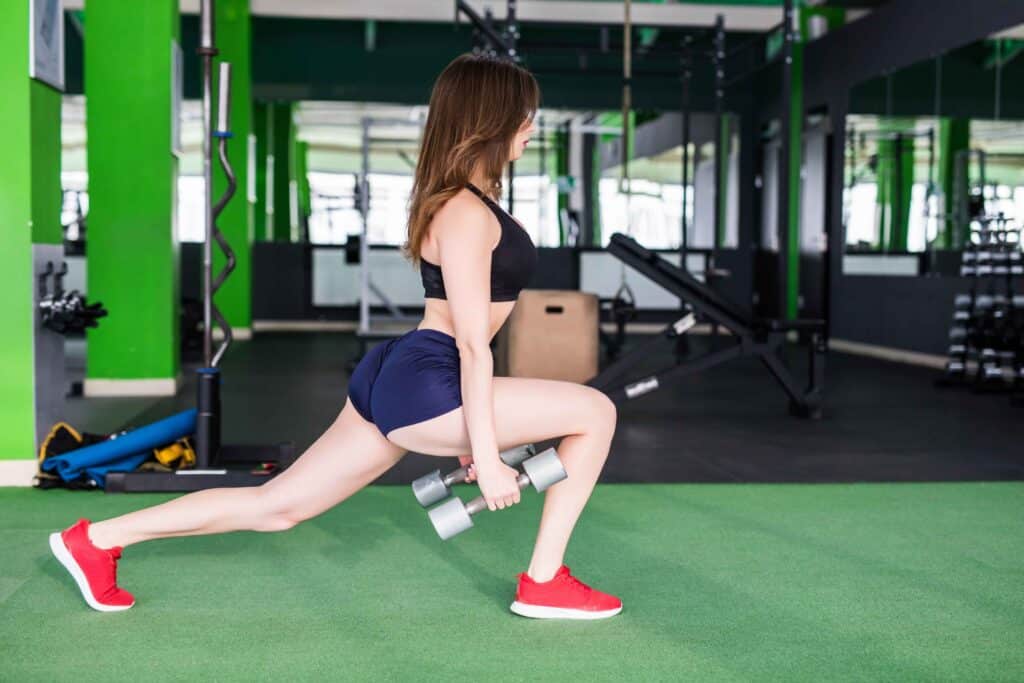Are you looking for a way to add a bit of extra oomph into your stretching routine?
Looking for something that will challenge and invigorate your body like never before?
Then ballistic stretching may be just the type of stretching you need.
Ballistic stretching is an intense form of dynamic stretching exercise that focuses on using quick, bouncy motions to improve flexibility.
This highly effective type of stretch can help enhance the range of motion, break up adhesions resulting from chronic injuries, reduce muscular soreness, and provide powerful relief from stiffness while providing long-lasting benefits with minimal risk of injury.
So why not give ballistic stretching a try today and let yourself experience the difference it can make:
Related: IT Band Stretches
What is Ballistic Training?
Ballistic stretching is a type of stretching exercise that involves using repetitive, bouncing movements to increase the range of motion of a muscle or group of muscles.
Unlike static stretching, where a stretch is held in a stationary position for a prolonged period, ballistic stretching relies on the momentum generated by bouncing or swinging motions to push the muscles beyond their usual range.
While ballistic stretching can help improve flexibility, it also carries a higher risk of injury compared to static stretching and may not be suitable for everyone.
What Are The Benefits Of Ballistic Stretching?
Here are some key benefits of ballistic stretching:
1. Increased Range of Motion (ROM)
Ballistic stretching engages muscles and joints in dynamic, forceful movements, pushing them beyond their typical range of motion.
This comprehensive stretching can be particularly advantageous for athletes who require exceptional flexibility in specific areas, such as gymnasts or martial artists.
2. Quick Results in Flexibility
The dynamic nature of ballistic stretching, incorporating bouncing and jerking movements, triggers a rapid response from the muscles.
This “tricking” effect encourages a quicker adaptation to increased length, making ballistic stretching an appealing choice for those seeking immediate improvements in flexibility, such as dancers or performers.
3. Improved Athletic Performance
Athletes often employ ballistic stretching to overcome training plateaus.
By expanding the range of motion, athletes can achieve better functional movement patterns, leading to enhanced performance in sports or activities that demand agility, precision, and an extended range of motion.
4. Enhanced Tendon Elasticity
Ballistic stretching contributes to improved elasticity of tendons, a critical component for athletes and individuals engaged in activities requiring explosive movements.
This enhanced flexibility helps prevent injuries related to tendon tightness, fostering overall joint health and resilience.
5. Improved Blood Circulation
The rapid contraction and relaxation of muscles during ballistic stretching act as a natural pump, promoting blood circulation.
This increased blood flow delivers oxygen and nutrients to muscles and joints, supporting their health and functionality while aiding in the prevention of injuries.
6. Increased Energy and Alertness
The quick, dynamic movements of ballistic stretching stimulate the cardiovascular system, increasing heart rate and blood flow.
This boost in circulation can result in heightened alertness and a surge of energy, making ballistic stretching an effective prelude to physical activity or a remedy for mid-day lethargy.
7. Versatility in Stretching Techniques
Ballistic stretching offers a range of techniques that can be customized to suit individual needs.
Whether focusing on dynamic stretches for specific muscle groups or incorporating varied bouncing patterns, the versatility of ballistic stretching allows for targeted improvements in flexibility and range of motion tailored to individual preferences and requirements.
What Are The Risks/Dangers Of Ballistic Stretching?
The dynamic and forceful nature of ballistic stretching can lead to various adverse outcomes, especially if not performed correctly.
Here are the risks and dangers associated with ballistic stretching:
· Overstretching and Muscular Injuries
One of the primary risks of ballistic stretching is the potential for overstretching muscles. The bouncing and jerking motions can stretch muscles beyond their natural limits, increasing the risk of strains, tears, and other muscular injuries.
· Increased Joint Stiffness
The forceful movements in ballistic stretching can place excessive stress on the joints, potentially leading to increased joint stiffness.
This heightened stiffness may result in discomfort and compromise joint health, especially if performed without proper warm-up or in individuals with existing joint issues.
· Worsening Existing Injuries
Individuals with pre-existing injuries should exercise caution when engaging in ballistic stretching. The rapid and forceful nature of the stretches can exacerbate existing injuries, leading to increased pain and delayed healing.
· Decreased Athletic Performance
Contrary to its potential benefits, ballistic stretching may disrupt the neuromuscular connection between muscles and the nervous system.
This disruption can negatively impact coordination, balance, and reaction time, ultimately impairing athletic performance and increasing the risk of injuries during physical activities.
· Delayed Onset Muscle Soreness (DOMS)
The bouncing and jerking movements in ballistic stretching can cause microscopic tears in the muscles, contributing to delayed onset muscle soreness (DOMS).
While some level of soreness is normal after exercise, excessive DOMS can impede recovery and hinder subsequent training sessions.
· Risk of Joint Injuries
The rapid and forceful nature of ballistic stretching can pose a risk to the integrity of joints, especially when performed without proper control.
This risk is heightened for individuals with joint conditions or those who have not built up sufficient flexibility through gradual stretching methods.
· Potential for Tendonitis
The forceful and rapid nature of ballistic stretching can increase the risk of tendon injuries, such as tendonitis.
Tendons, which connect muscles to bones, may become strained or inflamed due to the excessive stress placed on them during ballistic stretching.
FAQs
Is ballistic training suitable for beginners?
Ballistic training is generally considered an advanced form of exercise. Beginners may be at a higher risk of injury due to ballistic movements’ forceful and dynamic nature. It is recommended that individuals new to exercise start with more controlled and safer forms of training before attempting ballistic exercises.
What are the primary benefits of ballistic training?
Ballistic training can offer benefits such as increased flexibility, improved range of motion, enhanced athletic performance, and efficient warming up of muscles. It may also contribute to breaking through training plateaus. However, individuals should be aware of the associated risks and ensure they understand proper technique well.
Can ballistic training replace traditional stretching routines?
While ballistic training can contribute to increased flexibility, it should not replace traditional stretching routines entirely. Incorporating a variety of stretching methods, including static and dynamic stretches, may provide a more comprehensive approach to flexibility and injury prevention. It’s essential to tailor the stretching routine to individual needs and goals.
Are there specific precautions to take before engaging in ballistic training?
Yes, there are precautions to consider before starting ballistic training. Individuals should ensure they have a solid understanding of their own physical limitations, warm up adequately before engaging in ballistic exercises, and avoid this form of training if they have existing injuries or joint issues. Consulting with a fitness professional or healthcare provider is advisable, especially for those with health concerns.
How often should ballistic training be incorporated into a fitness routine?
The frequency of ballistic training depends on individual fitness levels, goals, and overall training program. In general, it is recommended to incorporate ballistic training 1-3 times per week, allowing for sufficient recovery between sessions. However, the intensity and duration of ballistic exercises should be gradually increased to prevent overtraining and reduce the risk of injuries.
Over To You
Ballistic stretching can provide immense benefits for athletes.
While the scope of this post was focused on discussing the benefits, risks, and techniques of ballistic stretching, it is ultimately up to each athlete to decide if ballistic stretching would be beneficial for improving their performance.
Proper supervision and guidance from qualified instructors are key in helping to decide whether the potential risks outweigh the rewards.
Furthermore, ballastics stretching should be approached cautiously and as part of a comprehensive mobility plan tailored to an individual’s specific needs and goals.
So, if you think ballistic stretching is right for you, get out there, challenge yourself with full body movements.







